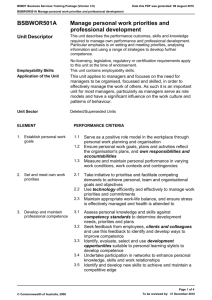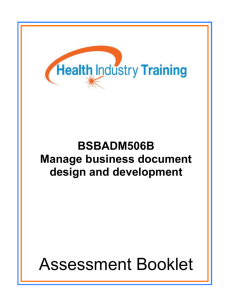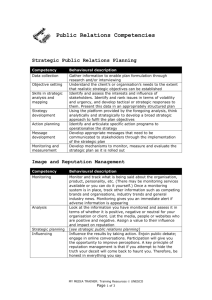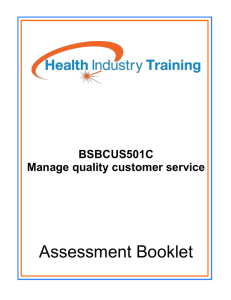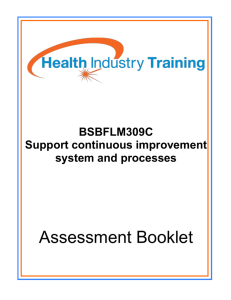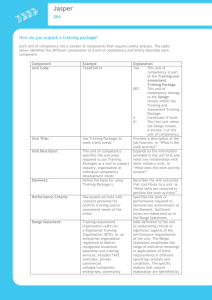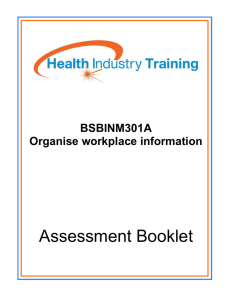HLTCSD201D-Maintain-high-standard-of-clien
advertisement
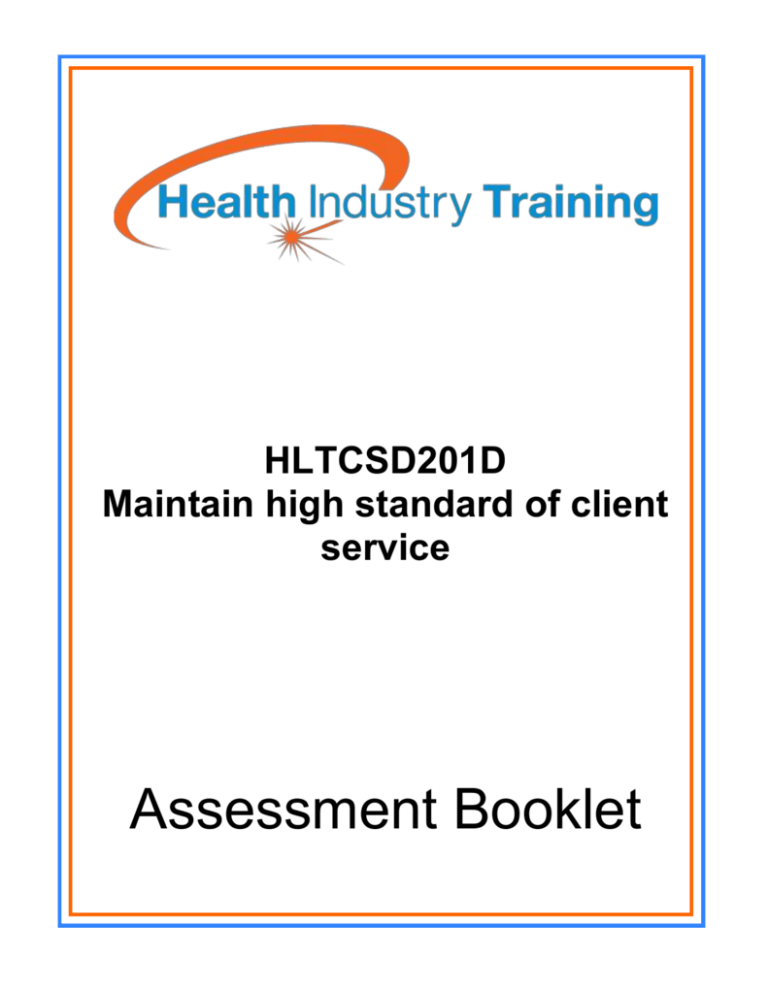
HLTCSD201D Maintain high standard of client service Assessment Booklet © Copyright 2011 GP Links Wide Bay trading as Health Industry Training PO Box 702 HERVEY BAY 4655 Version 2: August 2012 ASSESSMENT COVER SHEET Unit Code: HLTCSD201D Unit Title: Maintain high standard of client service Trainer Comments: ________________________________________________________________________________________ ________________________________________________________________________________________ ________________________________________________________________________________________ ________________________________________________________________________________________ ________________________________________________________________________________________ ________________________________________________________________________________________ ________________________________________________________________________________________ Student Name: ___________________________________________ Student No.: ___________________ Date Due: _____ / _____ / _____ Date Submitted: _____ / _____ / _____ Student Declaration: I declare that I understand how assessment will take place for this unit. I also understand that work completed towards this assessment must be verifiably my own. __________________________________ _____________________________________ ______________ Student Name Student signature Date Trainer Sign-off: I declare the above named student was assessed by me for the above mentioned unit __________________________________ _____________________________________ ______________ Trainer Name Trainer signature Date HLTCSD201D Maintain high standard of client service Assessment tool ASSESSMENT INFORMATION Competency based assessment The standards used to determine competency in different industry sectors are developed in conjunction with the relevant Industry Training Advisory Board (ITAB). These standards are endorsed by government in the form of specific industry national training packages. Assessment in a competency based course determines when competency has been achieved. To be assessed as competent a student must provide evidence that demonstrates they can perform the necessary skills and performances required including employability skills. To be competent a student is required to consistently demonstrate the skills, knowledge and performance criteria that are necessary to confidently complete the work tasks in a normal range of workplace conditions. The trainer/assessor is responsible for ensuring the evidence gathered by a student is: Authentic (verifiable the student’s own work) Valid (evidence is relevant to the unit of competency) Reliable (the student consistently meets the requirements of the unit of competency) Current (reflects the student’s current capacity to perform the tasks); and Sufficient (covers all the elements in the unit of competency and addresses the dimensions of competency) Dimensions of assessment The dimensions of competency relate to all aspects of work performance and include: Task skills: The student must perform the individual skills required to complete a work activity to the required standards. Task management skills: The student must manage a number of different tasks to complete a whole work activity. Contingency management skills: The student must use their problem-solving skills to resolve issues that arise when performing a work activity. Job/role environment skills: The student must perform effectively in the workplace when undertaking a work activity by working well with all stakeholders and following workplace policies and procedures. Access and equity All workers in the health and community services should be aware of access, equity and human rights issues in relation to their own area of work. They should develop their ability to work in a culturally diverse environment. Trainers and assessors must take into account relevant access and equity issues including the concept of social inclusion which ensures equitable access to services, to connect with others and to protect an individual’s right to be heard. Trainers and assessors must ensure the assessment process: is valid, reliable, flexible and fair is basis of sufficient evidence is one which offers valid, authentic and current evidence includes workplace requirements in a normal range of workplace conditions Health Industry Training Page 1 HLTCSD201D Maintain high standard of client service Assessment tool UNIT INFORMATION Unit code HLTCSD201D Unit title Maintain high standard of client service Unit descriptor This unit describes skills and knowledge for care assistance workers and other workers who have contact with clients required to deliver and maintain a high standard of service Employability skills This unit contains employability skills including communication, teamwork, problem solving, initiative and enterprise, planning and organising, self management, learning and technology Application of the unit This unit applies to work in a range of health settings where health services are provided with direct client contact involved. Work performed requires a range of well-developed skills where some discretion and judgement is required. Individuals will take responsibility for their own outputs and limited responsibility for the output of others Application of this unit should be contextualised to reflect any client service requirements, issues and practices specific to each workplace Unit sector or competency field None specified Pre-requisite, co-requisite or interdependent assessment of units None specified Context of and specific resources for assessment Method of assessment Critical aspects for assessment Health Industry Training This unit can be assessed independently; however holistic assessment practice with other community services units of competency is encouraged. Resources required for assessment include access to: - An appropriate workplace where assessment can take place or simulation of realistic workplace setting for assessment Assessment may include observation, questioning and evidence gathered from the workplace or simulated environment This unit is most appropriately assessed in the workplace or in a simulated workplace and under the normal range of work conditions This unit can be assessed independently, but holistic assessment practice is encouraged with other units of competency involving client service delivery Assessment may be conducted on one occasion but should include a range of clients, reflecting the diverse nature of those for whom service is provided in the workplace context A diversity of assessment tasks is also essential for holistic assessment Page 2 HLTCSD201D Maintain high standard of client service Assessment tool Required skills and knowledge Required knowledge: Roles and responsibilities of self and other workers within the organisation When client issues need to be referred to an appropriate health professional Organisation policies and procedures for privacy and confidentiality of information provided by clients and others Knowledge of cultures relevant to the particular service Cultural differences in Australia Available interpreter services Organisation policy on client rights and responsibilities Required Skills: Ability to: Work within role and responsibility in a manner which accommodates and accepts individual differences Comply with relevant policies, protocols, guidelines and procedures of the organisation Establish and maintain relationships, taking into account individual differences Interpret and follow the instructions and guidance of health professionals involved with the care of clients Handle complaints and resolve conflict, or refer matters to supervisors when required Work effectively as part of a team Communicate in a non discriminatory, supportive and inclusive manner Listen and respond to communication initiatives of client Demonstrate respect for clients, use effective listening techniques and display empathy with clients and relatives Use literacy skills in reading, writing and oral communication to fulfil job role in a safe manner and as specified by the organisation, including: - understand symbols used in WHS signs - read workplace safety pamphlets or procedure manuals and labels - use appropriate verbal and non verbal communication styles - ask questions - provide clear information - listen to and understand workplace instructions and clarify when necessary - apply literacy skills as required in English or a community language. Use problem solving skills to: - effectively utilise available resources - prioritise workload - Health Industry Training Page 3 HLTCSD201D Maintain high standard of client service Assessment tool Element Performance Criteria 1. Communicate appropriate with clients 1.1 Ensure participation in work team is constructive and collaborative and demonstrates an understanding of own role 1.2 Identify and use communication strategies and techniques to achieve most effective client service outcomes 1.3 Respond to and deal with complaints in line with organisation policy to enhance service to clients 1.4 Access interpreter services as required 1.5 Take action to resolve conflicts either directly, where a positive outcome can be immediately achieved, or by referral to appropriate personnel 2.1 Establish rapport with client and ensure the service is appropriate to and in the client’s best interest 2.2 Establish rapport with client and ensure the service is appropriate to and in the client’s best interest 2.3 Correctly identify client concerns and needs and respond within agreed level of responsibility, established procedures and guidelines for reporting to supervisors 2.4 Seek advice from appropriate sources to resolve any concerns or issues regarding relationship with, and/or service to clients when required 2.5 Consistently monitor and evaluate effectiveness of interpersonal interaction to ensure best client service outcomes 3.1 Positively, actively and consistently demonstrate respect for differences in all work 3.2 Maintain confidentiality and privacy of clients 3.3 Demonstrate courtesy in all interactions with clients, their visitors, carers and family 3.4 Provide assistance with the care of clients with challenging behaviour in accordance with established procedures 3.5 Provide assistance with the care of clients with challenging behaviour in accordance with established procedures 4.1 Seek and receive advice and assistance from appropriate sources on own performance 4.2 Adjust own work to incorporate advice that addresses performance issues, to maintain the agreed standard of client support and service 2. Establish and maintain an appropriate relationship with clients 3. Act in a respectful manner at all times 4. Evaluate own work to maintain a high standard of client service Health Industry Training Page 4 HLTCSD201D Maintain high standard of client service Assessment tool ASSESSMENT TOOLS Assessment is conducted throughout the course using different assessment tools including written/oral assessment, projects, observation, third party reports, simulation/case studies and portfolios. Both skills and knowledge are assessed in line with the requirements of the Australian Quality Training Framework (AQTF) and the training package. Health Industry Training will use different methods of assessment to ensure sufficient evidence can be gathered to demonstrate a student can perform a task against the specified criteria. Assessment methods can include: Questioning: questions asked orally or in a written format. Written questioning is widely used in competency based assessment to assess a student’s understanding and knowledge of the task they are performing. Projects: are used for relevant units that require students to demonstrate a high level of research and analytical skills. Observation: practical demonstration of real work or simulation by the trainer Third party reports: confirmation of consistent performance by the student to meet key performance indicators over time and a range of contexts. Simulation/Case-study: simulation of the workplace to gauge competency. Demonstrated performance knowledge against a define case study or scenario. Portfolio: collection of individual pieces of evidence to demonstrate work outputs by the student. Evidence can be gathered from day to day work, certificated learning and other activities such as past achievements. Other assessment activities determined by the trainer could include a range of assessment tools appropriate for this unit to demonstrate competencies which sufficiently address: The elements and performance criteria Critical aspects for assessment The essential skills and knowledge The context and consistency of the assessment requirements The relevant employability skills Recognition of Prior Learning Recognition of Prior Learning (RPL) is a formal recognition of your current skills and knowledge you have achieved outside the education and training system. RPL takes into account any previous formal study, work and life experience and then assesses this against the elements of competency to determine if you can receive credit toward a qualification. Students seeking recognition can apply by contacting the Manager Health Industry Training at the commencement of study. Credit Transfer Students who have completed a formal unit within their intended qualification with another Registered Training Organisation (RTO) may be able to apply for a credit transfer or exemption. A certified copy of the original documentation must be provided when applying for a credit transfer. Health Industry Training Page 5 HLTCSD201D Maintain high standard of client service Assessment tool ASSESSMENT INSTRUCTIONS Assessment format and layout All assessments must be: Typed in Arial 12, single spacing with headings in bold Header and Footer to be inserted in each page. Header to include unit code and title. Footer to include student name and page number All work must be referenced throughout the assessment. Referencing should include author and year of publication and website address (if applicable). There are many referencing guides available on the Internet to assist students. Plagiarism Plagiarism is the act of representing as one's own original work the creative works of another, without appropriate acknowledgment of the author or source. In all written work submitted for assessment you must show the sources for your material. The principle is that whenever submitted material is not your own original work this must be referenced to acknowledge the author’s work. It is expected that when a student submits an assessment that it is the independent work of that student and they have written it in their own words. If a student has plagiarised another person’s work they will be asked to resubmit their assessment. Plagiarism can lead to instant dismissal. Submission All assessments must be submitted in the format described. A date for submission will be set by the trainer. Assessments must be submitted on or before this date or an extension must be granted by the trainer. The assessment cover sheets must be detached from the assessment booklets and attached to the front of each assessment. All sections of the cover sheet must be completed by the student prior to submission of assessment. The bottom section of the assessment cover sheet will be retained by the trainer. Resubmitting assessments If a student is marked ‘not competent’ they will be provided with an alternative assessment for completion to be able to demonstrate competency. An assessment resubmission should be treated as the original assessment with all principles applying. Health Industry Training Page 6 HLTCSD201D Maintain high standard of client service Assessment tool ASSESSMENT - HLTCSD201D Maintain high standard of client service In your own words, answer the following questions. To be marked as competent in this unit, you must provide sufficient responses to each question. Bullet points must only be used where applicable eg: if the question asks you to list name or give examples. Questions 1. What do you consider key skills for good communication? 2. How might you evaluate your own skills as a communicator? 3. What is meant by the term ‘cultural awareness’? 4. How do you think you can maintain a professional relationship with clients? 5. How would you manage the situation if a client disagreed with the services you were suggesting? 6. Explain what the terms ‘discretion’ and ‘confidentiality’ mean to you and how you would apply them in a professional, community care relationship. 7. What are KPIs? Explain how they work. 8. What types of relevant information do you think would come out of an evaluation session? To be marked as competent in this unit, you must provide sufficient information in the project report. Project You are working in a health service organisation and you have been asked to make a presentation at a community meeting, in your presentation you should show and explain to the community members how your organisation operates with regards to: Team work participation and communication strategies and techniques to achieve effective client service outcomes How your organisation deals with conflict and complaints Methods used to consider the individual, special and cultural needs of clients How clients are encouraged to communicate with carers and to discuss issues or problems and to expect appropriate responses Methods of ensuring that clients/patients have access to other professional services as needed Methods used by the organisation to ensure that client information is respected and treated as confidential How the organisation might manage and respond to challenging or difficult behaviours Write an assessment covering all of these points, showing the information you would share with the community members, information could be in the form of a PowerPoint presentation if you wish including slide notes. Health Industry Training Page 7
